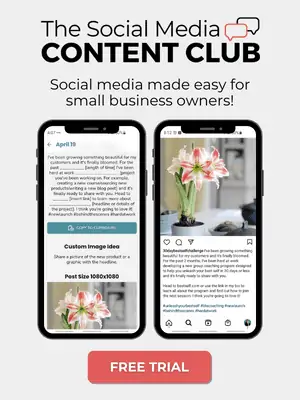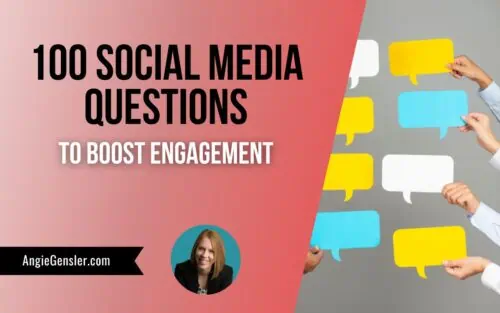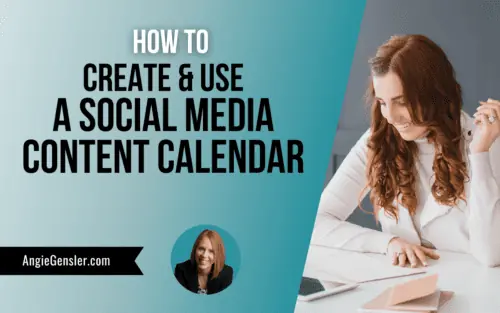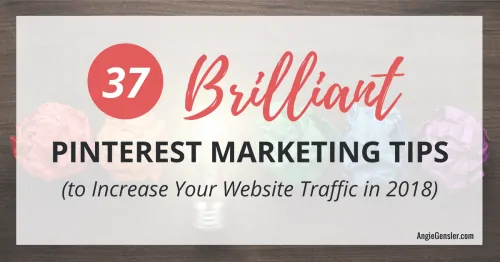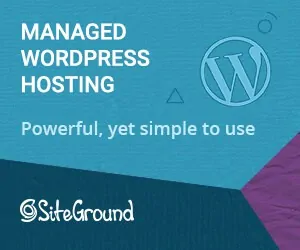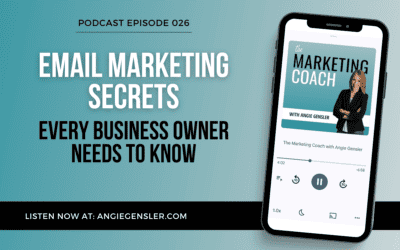
Welcome to The Marketing Coach podcast, the go-to destination for small business owners and marketers seeking to boost their traffic, leads, and sales without the hustle or headache.
Dive into the raw realities of online business as Angie Gensler shares personal hurdles with haters and strategies for spinning negativity into business success.
This isn’t just a guide; it’s a masterclass in emotional resilience with invaluable insights into turning critics into catalysts for growth.
Inside this episode, you’ll learn about:
- Overcoming the fear of internet trolls
- Negative feedback’s disproportionate impact
- The psychology behind negative comments with the Negativity Bias
- The role of a “praise board”
- Waiting to respond: a strategic move
- Turning negative comments into growth
Please Leave a Review
If you liked this episode, please support the show and leave an honest rating or review on Apple Podcasts or your favorite podcast app.
Keep Listening
- Episode 23: Marketing Strategies Every Business Needs in 2024
- Episode 22: Are Reels Worth Your Time on Social Media?
- Episode 21: 19 Productivity Hacks for Busy Entrepreneurs
Transcript with Timestamps
This transcript was generated with AI assistance and may include minor spelling and grammatical errors. For the best experience, we recommend listening to the audio version of the podcast.
00:05
Welcome to the Marketing Coach podcast. I’m your host, Angie Gensler, and I teach you how to get more traffic, leads, and sales without the hustle or headache. Let’s get started.
00:17
Hey guys. Today we’re talking about something that every business owner and marketer encounters at some point, and that is dealing with haters, trolls and angry customers. I have had my fair share of challenges in this area, sad to say, and I know that many of you have too. I also know that the fear of haters and trolls might actually be keeping you from starting your dream business or from fully putting yourself out there. I know this because that exact fear almost kept me from starting Angiegensler.com. Eight years ago, Trevor and I started talking about business ideas so I could quit my corporate job, and Trevor kept pushing the idea of an online business and blog, but I resisted that idea for months because I was terrified of internet trolls. Now obviously, he eventually convinced me to go for it, and I’m so glad he did because eight years later, we now get to work from home on a very reduced work schedule, and we have the financial freedom and the time freedom to travel as much as we want and to work when and where we want.
01:24
Honestly, it is an absolute dream, but it doesn’t come without a lot of challenges. And the biggest challenge for me personally is dealing with the haters, trolls and angry customers, which a quick side note about angry customers, they’re going to happen no matter how incredible your customer services or how amazing your products and services are. It’s really just the nature of running a business. We get compliments all the time about the amazing customer service that Trevor provides, but no matter how hard he works or how generous or kind he is, there are always a handful of people who leave us angry. And I have to be honest, those angry customers cut me so deep. They hurt 10 times worse than a mean comment from an internet troll. And I think that’s because the trolls I can ride off as well. They don’t know me and they don’t know what they’re talking about.
02:23
But with a customer, I feel like that’s someone who gave me a chance, they trusted me and I failed them, and that hurts so deeply. So the idea for this episode actually stemmed from an angry customer last week. She emailed us requesting a refund from a purchase because she used the wrong credit card. She needed to use her business card instead, so she wanted her personal card refunded, and then she would redo the purchase with her business card, which was a very understandable request. Trevor got her email about 1:00 PM in the afternoon, and then later that night he sat down at his desk after we all went to bed to take care of her refund and do some other customer service. Now, sadly, when he sat down, the first email in his inbox was a scathing email from her insulting my character and saying that we were so unprofessional that just destroyed me.
00:05
Welcome to the Marketing Coach podcast. I’m your host, Angie Gensler, and I teach you how to get more traffic, leads, and sales without the hustle or headache. Let’s get started.
00:17
Hey guys. Today we’re talking about something that every business owner and marketer encounters at some point, and that is dealing with haters, trolls and angry customers. I have had my fair share of challenges in this area, sad to say, and I know that many of you have too. I also know that the fear of haters and trolls might actually be keeping you from starting your dream business or from fully putting yourself out there. I know this because that exact fear almost kept me from starting Angiegensler.com. Eight years ago, Trevor and I started talking about business ideas so I could quit my corporate job, and Trevor kept pushing the idea of an online business and blog, but I resisted that idea for months because I was terrified of internet trolls. Now obviously, he eventually convinced me to go for it, and I’m so glad he did because eight years later, we now get to work from home on a very reduced work schedule, and we have the financial freedom and the time freedom to travel as much as we want and to work when and where we want.
01:24
Honestly, it is an absolute dream, but it doesn’t come without a lot of challenges. And the biggest challenge for me personally is dealing with the haters, trolls and angry customers, which a quick side note about angry customers, they’re going to happen no matter how incredible your customer services or how amazing your products and services are. It’s really just the nature of running a business. We get compliments all the time about the amazing customer service that Trevor provides, but no matter how hard he works or how generous or kind he is, there are always a handful of people who leave us angry. And I have to be honest, those angry customers cut me so deep. They hurt 10 times worse than a mean comment from an internet troll. And I think that’s because the trolls I can ride off as well. They don’t know me and they don’t know what they’re talking about.
02:23
But with a customer, I feel like that’s someone who gave me a chance, they trusted me and I failed them, and that hurts so deeply. So the idea for this episode actually stemmed from an angry customer last week. She emailed us requesting a refund from a purchase because she used the wrong credit card. She needed to use her business card instead, so she wanted her personal card refunded, and then she would redo the purchase with her business card, which was a very understandable request. Trevor got her email about 1:00 PM in the afternoon, and then later that night he sat down at his desk after we all went to bed to take care of her refund and do some other customer service. Now, sadly, when he sat down, the first email in his inbox was a scathing email from her insulting my character and saying that we were so unprofessional that just destroyed me.
03:20
And that’s because to me, integrity is everything. I genuinely want every single customer to become a raving fan and just absolutely thrilled with their purchase. I put so much of myself into everything that I create, so it really pains me to my core when someone tells me that they think my work sucks or that I suck. But you know what? As much as that hurt me, I survived. I am here a week later and and I’m okay. We responded to that angry customer. Our business is continuing to serve others in a meaningful way, and this is just a small price to pay for a business that provides our dream life. And I shared that example with you because I want to demonstrate to you that being a business owner doesn’t mean that you have to have this tough skin and nothing can ever affect you or hurt you.
04:12
It’s normal, it’s human to have your feelings hurt when someone sends you a nasty note. That’s pretty normal. So don’t feel like there’s something wrong with you when those comments really upset you or seem to ruin your day. That does not mean that you’re not cut out to be a business owner. It just means you need some strategies under your belt to help you handle these negative comments. So let’s dig in and talk about how to handle them, which can range from a simple comment on a YouTube video to a scathing email to your customer service team. Now, first I wanna talk about the psychology behind why negative comments can have such a profound impact on us. There’s a phenomenon called the negativity bias, and this is when our brains tend to focus more on negative experiences than positive ones. And this bias can lead us to fixate on that one bad comment, which overshadows the dozens of positive interactions we’ve had.
05:08
And once we’ve fixated on that one negative comment or that one unhappy customer, we tend to spiral outta control and think that our business is ruined, we’re horrible people, and the world’s going to end. But understanding the negativity bias is actually the first step in pushing past that negativity that you’re going to experience as a business owner. So why are our brains wired to focus more on negative experiences than positive ones? The negativity bias is essentially a cognitive phenomenon ingrained in us as a survival instinct. So back in our ancestors’ time being hyper aware of potential threats was essential for survival. The brain evolved to prioritize negative stimuli because overlooking a danger like a saber-tooth tiger coming your way could have dire consequences in a world filled with predators. And so much uncertainty. Our ancestors had to be vigilant to stay alive, they had to be searching for all this negativity in the landscape.
06:13
Now, while we’ve come a long way from those primitive times and we no longer have to worry about saber-tooth tigers, our brains still carry their evolutionary baggage of our ancestors. So in the context of marketing and social interactions, the negativity bias means that we are naturally more attuned to negative comments, criticism, threats. As you know, those things once signaled potential dangers to our own survival. Now, we know cognitively that those things don’t pose a danger to our actual survival, but that’s what our brain makes us think. So when you understand the negativity bias, you know, it really helps you to recognize that your brain is predisposed to fixate on negativity when you receive a hundred positive comments, but just one negative remark, that one negative comment is what tends to occupy your thoughts. And this is sad because that means that negative feedback has a disproportionate impact on your emotions and your wellbeing.
07:17
Now, it’s not a flaw in your character. So I want you to remember that it doesn’t mean you’re not cut out for business. This is just a function of all of our wiring that you need to consciously navigate. So the next time you find yourself dwelling on a single bad comment, remember that it’s part of your evolutionary legacy. Recognizing the negativity bias is the first step in overcoming its influence and maintaining a balanced perspective on the feedback that you receive. Now that we’ve explored the psychology behind the negativity bias, let’s talk about some actionable strategies that you can use to counter its impact as well as how to handle the negative comments. So the first strategy is to create what I call a praise board. A praise board is essentially a physical or digital space where you compile and display positive comments, reviews, and testimonials about your business.
08:13
Now, when you create your praise board, you wanna make sure to include a diverse range of positive feedback. So this could be customer testimonials, glowing reviews, uplifting comments from your community, maybe it’s awards that you’ve received. Really the goal is to showcase all the different ways that you are making a positive impact on others, and make sure that you don’t let your praise board become stagnant. So this is not a one and done. You know, you create it one time and that’s it. You want to regularly be updating it with fresh and positive feedback. And you wanna do this for two reasons. So first, it reinforces the idea that positive interactions are common for your business. And then second, by doing that, it helps shift your mind away from the negativity bias and helps you develop the habit of looking for positive feedback. So if you know that, okay, I need to be constantly updating this praise board, now your brain is trying to search out the positive instead of searching out the negative.
09:16
This is a powerful strategy to help you override that negativity bias. And then once you have your praise board created, I want you to place it in a location where you’re going to see it often. So whether it’s a physical board within your office, or maybe it’s a digital board that you create and set as your computer, desktop, whatever it is, the key is to have these positive messages easily accessible and essentially in your face throughout your day to serve as this constant reminder that the work that you are doing is valued. And if you do have employees, make sure that you extend the benefits of the praise board to your team. You wanna share the positive feedback that you’ve been receiving during team meetings or through some sort of communication channels to your employees. Doing this fosters a really great work environment and it reminds everyone working for you of the impact that they’re making.
10:10
Everybody wants to feel purpose in their work, and this is going to help your employees stay more engaged and thrilled about the work that they’re doing. Now, maybe you’re just starting your business, you don’t have any employees, you don’t have any customers, so you don’t have any sort of praise. I still want you to create a praise board, but you’re gonna fill it with past accomplishments. So fill it with praise from former coworkers, bosses, classmates, friends, or even your relatives. I don’t care if your praise board is filled with love notes from your mom. Whatever it is, you need to load it up with some sort of positive messages or even some positive affirmations, and it’s going to be something that will remind you that you are amazing, you are loved, and your work and your contributions are appreciated. So the first step in dealing with the haters, trolls and angry customers is to create a praise board.
11:03
Now, let’s talk about how to handle those negative comments when they come in. So when a nasty message comes through, it tends to trigger a spectrum of emotions within us. We feel all the feels and it’s essential to navigate them mindfully. So that’s why the next strategy is to wait to respond. Now, here is why waiting to respond is a game changer. When confronted with negativity, we tend to experience a flood of emotions from frustration and anger to self-doubt. These feelings can cloud our judgment and tend to prompt really impulsive reactions that we later regret. It’s in these moments that the importance of waiting to respond becomes very evident. Instead of reacting in the heat of the moment and saying something that you’re gonna regret, take a step back, walk away from your computer, or let the customer know that you need to consult with someone else and that you’ll get back to them.
12:03
These few moments of distance can make a world of difference and how you process and respond to the situation. So one effective practice during this time is to redirect your focus. So wait to respond and then shift your attention to your praise board. So here’s where your praise board really comes in handy. You’re going to look to it and remind yourself of the positive impact that your brand has had. Read all those messages, and hopefully allow those to overpower this one negative message and keep you from spiraling down this negativity funnel of self-hate and self-doubt. It’s not healthy. So this praise board not only helps counteract the immediate negativity, but it really serves as a grounding force for you, and it helps you get a little bit of perspective. Now, I’m going to be honest, the praise board is not going to magically make all the bad feelings go away, but it is necessary to remind yourself of all the good that you’ve done if you’re ever going to overcome that negativity bias.
13:10
So because the praise board is not a magic panacea, you’re also going to wanna take some time to meditate, go for a walk, or maybe spend time with someone who loves you and use that time to think about your response or just completely get your mind off of it altogether. And really just use that as a time to recenter yourself, ground yourself, and delay your response. These activities will help provide that mental reset that you need and which will allow you to come back to the situation later with a clearer mind. Now, the goal with this is not to suppress your emotions, but it’s to process them in a constructive way. And it’s also not about avoiding criticism or sweeping the issues under the rug or ignoring them and pretending they don’t exist. It’s really about taking the time to gather your thoughts, compose yourself, and then respond from a place of professionalism.
14:07
Waiting to respond is just a strategic move that can turn a potentially damaging interaction into an opportunity for constructive resolution. Years ago, I had someone comment on my YouTube video that I was a stupid C word. Now, first, let me tell you, I was shocked to see that word on my computer screen and really horrified that someone called me that my body instantly went into fight mode and I was ready to go to battle with this person. I could have replied with some choice words of my own and lots of anger right back at them, but that would’ve only made the situation worse and it would’ve looked really unprofessional. Instead, I took a timeout, reminded myself of all the nice comments I’ve received on my videos, and then I calmly deleted the comment and blocked the person. Which side note, for you guys, just because you’re a business owner does not mean you have to put up with hateful comments.
15:06
Criticism is one thing, you can use that to better your business, and you can thank the person for it. But hate is an entirely different thing. When someone sends you hateful or abusive messages, I’m giving you permission to delete them and block the person. Your life is way too short, and the world is full of too many wonderful people for you to subject yourself or your employees to that type of abuse. It’s never acceptable. Okay, I got a little off track there. So let’s recap. You’ve made your praise board and you’ve taken some time to respond. You’ve waited, you’ve looked at your praise board, you’ve maybe gone for a walk to talked to a friend or a loved one. And then when you’re ready, your next step is to respond with empathy. Now, negative comments often stem from genuine concerns, misunderstandings, or maybe some unmet expectations.
16:00
Some strong emotions were obviously present when the person wrote you the negative message. So responding with empathy acknowledges the emotions behind the criticism or behind the anger, and addresses those emotions in a compassionate manner. Responding with empathy means that you are essentially walking in the shoes of the person expressing their dissatisfaction. You want to consider the situation from their perspective, think about what led them to feel this way. This shift in your perspective, allows you to respond in a way that acknowledges their experience without necessarily agreeing with their assessment. Empathy doesn’t mean agreeing with the criticism, but it does involve recognizing valid concerns. So if the negative comment highlights an area where your business can improve, acknowledge it. This not only demonstrates humility, but it shows your commitment to a continuous improvement as a business. Empathetic responses really have the power to shift the narrative from confrontation to resolution.
17:01
By expressing your understanding and a willingness to address concerns, you’re opening the door for constructive dialogue, which can lead to problem solving. And in some cases, you can even turn that dissatisfied customer into a brand advocate. Responding with empathy is easier said than done. It’s not easy when you are hurt and angry. Even sometimes when you wait to respond, you take that break, you think about it, there’s still going to be some hurt and anger there. So if you’re still struggling to put yourself in their shoes and you’re struggling to disassociate from those hurt feelings that you, you may be feeling, I recommend that you use chat GPT or some other AI tool to help craft your response. So you’re gonna open up your AI tool, you’re gonna explain the situation, share a few thoughts on maybe how you’d like to respond, and then ask chat GTP to write you a polite response.
17:56
We have done this many times and it is insanely helpful. Sometimes it’s hard to pull out the right words that you need when you’re so hurt or you’re, you’re feeling like maybe you’re getting an unfair treatment. But Chad GTP isn’t biased. It doesn’t have these emotions, so it’s a great tool to help you find those words that you need and maybe a time where you’re not feeling completely empathetic. Remember though that this is a tool to enhance your communication, not to completely replace it. So you wanna use it to enhance your response and as a supplement to your own words. So make sure that you’re not just copying and pasting whatever it says. Make sure you take some time to edit and make it a very thoughtful response. Now, once you have responded to the negative comment, the next step is to focus on improvement.
18:46
So instead of dwelling on negative comments, you wanna use them as constructive feedback for improvement. Most every critique is an opportunity to enhance your products or services. Now, I say this because that one comment that I got on that YouTube video, there was nothing constructive that I could do with that to make any sort of improvement. But typically, if it’s coming from an angry customer, there’s usually something that you can pull from that will help you improve your processes, your products, your systems, whatever it may be. Negative comments really can provide a unique perspective on aspects of your products or services that you may not be aware of and may need some attention. So use them as opportunities to gather insights and understand your customer’s needs and their expectations. Now, if you’re a team of one, this is easy to do. You’re the one fielding all of the feedback.
19:36
But if you have employees or you have a customer service rep, then I recommend setting aside some time once a month or maybe once a quarter and review all of the positive and negative feedback with them. See if you can identify any recurring themes in the negative comments, and that’ll help you pinpoint areas that may need some improvement. And this is helpful because instead of viewing negative feedback as a one-time issue, it helps you view it as helpful and allows you to make these changes along the way. So it helps you refine processes, enhance product features, or maybe even optimize your customer service protocols and systems that you have in place. And these small, consistent improvements over time can lead to really significant progress in the long run and help you improve and grow your business. So focusing on improvement is not just about addressing negative comments, it’s about evolving and growing your business and providing a better product and service to all of your customers.
20:39
It’s really an opportunity for growth for you. Okay, and with that, that wraps up the strategies I have for you today to deal with haters, trolls and angry customers. Just remember that when running a business dealing with negativity is inevitable, it’s how we handle it that defines our success. So don’t let the negativity bias us win. Remember that a single bad comment does not outweigh the multitude of positive experiences that you create with your customers. Embrace these negative comments and challenges as opportunities for growth and use them to build a stronger, more resilient business. I hope you guys found this episode helpful and discovered a strategy that you want to implement. The next time you have to deal with a negative comment. And before we part ways, remember that perseverance, not perfection, is the key to success. If you keep taking action, your success is inevitable. I’m cheering you on.
If you liked this episode and learned something new make sure you rate review and subscribe to the podcast. And if you haven’t given the Social Media Content Club a try yet, head over to Angiegensler.com/content club to start your seven-day trial of done for you, copy and paste content directly from your phone. You’re going to love it. Well, that’s it for today. Have a great day, and I will see you in the next episode.




